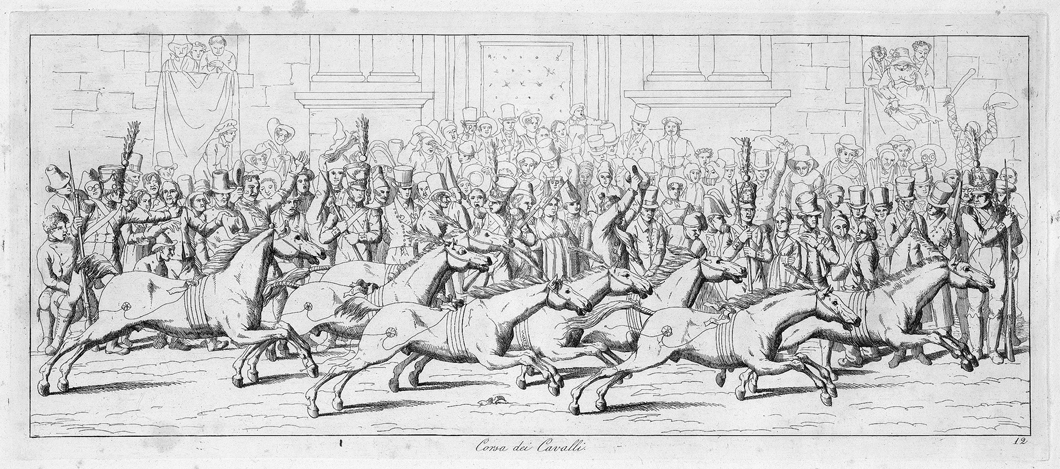Loading the page ...
Hjalmar Carl Gustaf Mörner
(1794 Stockholm – 1837 Paris)
Il Carnevale di Roma. Title page, printed list of contents, 20 etchings, each measuring about 20.8 x 47 cm. In a contemporary half-leather binding (edges scuffed and minor damage to spine) with a red cover label. Rome, Presso Francesco Bourlié, 1820.
Carl Gustaf Hjalmar, Count Mörner, who came from a noble family closely linked to the Swedish royal household, embarked on a military career as an officer in the Royal Guard. Quite in keeping with the customs of his lofty rank, he also cultivated his artistic inclinations and achieved prominence as a painter and printmaker. Nagler describes him as a man, "whom Nature has endowed with a rich artistic talent". Mörner spent over a decade in Rome (1816–1828) and produced a quite extensive œuvre of paintings, watercolours and graphic works which pay lively and often humorous testimony to this sojourn. A characteristic example is the present etching cycle dedicated to the famous Roman Carnival, whose wealth of narrative and folkloric details make it a significant document of cultural history. Johann Wolfgang von Goethe was also enthusiastic about this genuinely popular festival during his second stay in Rome (1787–1788) and wrote a memorable record of it.
In terms of anecdotal variety Mörner’s visual portrayal of the Roman carnival is in no way inferior to Goethe’s written account. No aspect of the turbulent feast has been omitted. The title page opens with the preparations for the festivities. In a bottega some elegant gentlemen are donning their costumes, while notices announce theatrical performances and balls. There follow the portrayal of a boisterous dance in front of a popular tavern and four vedute of the Piazza del Popolo, whose structures have been sketched in faintly but accurately. A motley crowd consisting of people of all ages watches from the wooden stands as the jesters in their fancy costumes go prancing merrily past, while respectable Romans set off on a coach ride over the Via del Corso. The narrow rectangular format of the compositions is excellently suited to presenting to great scenic effect the various episodes of the carnival unfolding on Rome’s main thoroughfare. In a kind of continuous narrative we see a long procession of the most varied personages: comical characters in Commedia dell’arte costumes, Roman types in all their picturesque variety, peasants and shepherds from the Campagna in folk costume, as well as aristocrats and citizens out for a stroll. The colourful procession serves as a kind of prelude to the real scenic climax of the carnival, the horse races, which is the subject of the next picture. The successive print shows very well how the mass of spectators at the upper end of the Via del Corso keep an expectant lookout for the arrival of the horses. By now it is evening, and Mörner depicts with palpable enjoyment the ritual of the mocoletti that takes place on Shrove Tuesday, in which revellers carry lighted candles in their hands while trying to blow out those of others. A glittering gala in the Teatro Aliberti, where Romans of all walks of life are gathered, and a late-night meal in a humble inn end Mörner’s suggestive and humorous portrayal of the carnival. His spare, slightly naive drawing style suits the folkloric character of the festival and lends the individual scenes a high degree of earthy vigour and dramatic flair.
Superb, contrasting impressions with full margins. Minor ageing, otherwise in excellent condition.
